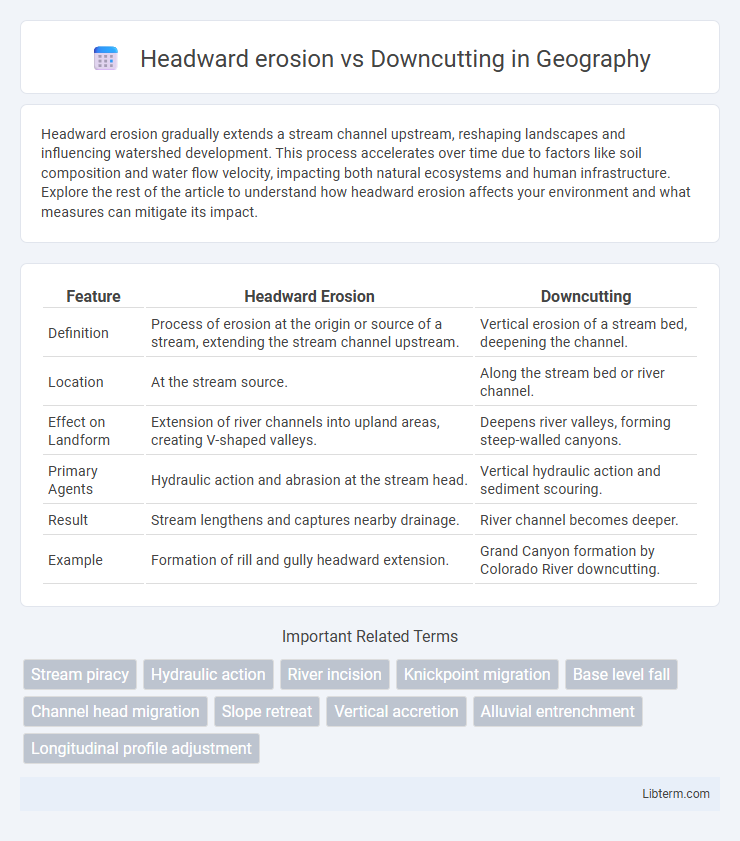Headward erosion gradually extends a stream channel upstream, reshaping landscapes and influencing watershed development. This process accelerates over time due to factors like soil composition and water flow velocity, impacting both natural ecosystems and human infrastructure. Explore the rest of the article to understand how headward erosion affects your environment and what measures can mitigate its impact.
Table of Comparison
| Feature | Headward Erosion | Downcutting |
|---|---|---|
| Definition | Process of erosion at the origin or source of a stream, extending the stream channel upstream. | Vertical erosion of a stream bed, deepening the channel. |
| Location | At the stream source. | Along the stream bed or river channel. |
| Effect on Landform | Extension of river channels into upland areas, creating V-shaped valleys. | Deepens river valleys, forming steep-walled canyons. |
| Primary Agents | Hydraulic action and abrasion at the stream head. | Vertical hydraulic action and sediment scouring. |
| Result | Stream lengthens and captures nearby drainage. | River channel becomes deeper. |
| Example | Formation of rill and gully headward extension. | Grand Canyon formation by Colorado River downcutting. |
Introduction to Fluvial Erosion
Headward erosion and downcutting are fundamental processes in fluvial erosion shaping river landscapes. Headward erosion extends a stream channel upstream, lengthening the river by removing soil and rock at its origin. Downcutting deepens the riverbed by eroding downward, creating valleys and influencing sediment transport dynamics.
Defining Headward Erosion
Headward erosion is the process where a stream channel lengthens upstream, extending its source by eroding material at the origin of the stream. This phenomenon contrasts with downcutting, which focuses on deepening the stream bed by vertical erosion. Headward erosion significantly influences drainage basin expansion and landscape evolution by driving the network's growth toward higher elevations.
Understanding Downcutting
Downcutting is the vertical erosion process where a river or stream deepens its channel by removing sediment and bedrock from the riverbed, directly influencing the landscape's elevation profile. This process is driven by the river's energy and velocity, typically occurring in youthful river stages with steep gradients. Understanding downcutting is essential for analyzing river incision rates, sediment transport, and the formation of features such as canyons and gorges.
Key Differences Between Headward Erosion and Downcutting
Headward erosion refers to the process where a stream channel lengthens at its origin, extending uphill by eroding soil and rock, while downcutting involves the deepening of the stream channel by vertical erosion into the bedrock or sediment. Key differences include the direction of erosion--headward erosion moves upstream, expanding the drainage area, whereas downcutting lowers the channel bed and increases channel depth. Headward erosion often leads to the formation of new valleys, while downcutting shapes valley depth and steepness.
Geomorphological Processes Involved
Headward erosion and downcutting are key geomorphological processes shaping river valleys and drainage networks. Headward erosion lengthens a stream channel by eroding sediment and rock at its origin, driving upstream extension often due to water flow or mass wasting. Downcutting deepens the riverbed through vertical erosion, lowering the river profile and forming features such as canyons and gorges by removing bedrock and sediment along the channel floor.
Factors Influencing Headward Erosion
Factors influencing headward erosion include rock type, gradient, and water discharge, which determine the rate of upstream channel extension. Soil permeability and vegetation cover affect erosion susceptibility by stabilizing banks and controlling runoff velocity. Climate patterns, particularly rainfall intensity and frequency, also play a crucial role in accelerating or inhibiting headward erosion processes.
Factors Affecting Downcutting
Downcutting is primarily influenced by factors such as river discharge, sediment load, bedrock resistance, and base level changes. High river discharge increases the stream's erosive power, while sediment load can either abrade the bedrock or protect it from erosion depending on its composition and amount. Changes in base level, such as sea level fluctuations or tectonic uplift, directly affect the stream's potential energy, driving the rate of vertical incision or downcutting.
Examples of Headward Erosion in Nature
Headward erosion occurs as a stream or river channel lengthens its course by eroding upstream, commonly seen in the formation of river valleys like the Grand Canyon and Ohio River. These examples exhibit intense upstream cutting where tributaries extend their channels through soil and rock, often leading to drainage basin expansion. Unlike downcutting, which deepens the river channel vertically, headward erosion predominantly extends the channel horizontally by removing material from the headwaters.
Real-World Cases of Downcutting
Downcutting occurs when a river or stream erodes its bed downward, deepening the channel and often forming features like canyons and gorges; the Colorado River's Grand Canyon exemplifies intense downcutting over millions of years. Headward erosion, by contrast, involves the lengthening of a stream channel at its source, extending the drainage basin upstream. Real-world downcutting events include the Mississippi River's incision through sediment layers, shaping deep valleys and altering floodplain dynamics.
Environmental Impacts and Significance
Headward erosion accelerates landscape evolution by extending river valleys upstream, causing increased sediment transport and habitat disruption in headwater regions. Downcutting deepens river channels, leading to alterations in groundwater levels and destabilization of adjacent ecosystems due to riverbed incision. Both processes significantly impact watershed hydrology and sediment dynamics, influencing floodplain fertility and biodiversity conservation.
Headward erosion Infographic

 libterm.com
libterm.com